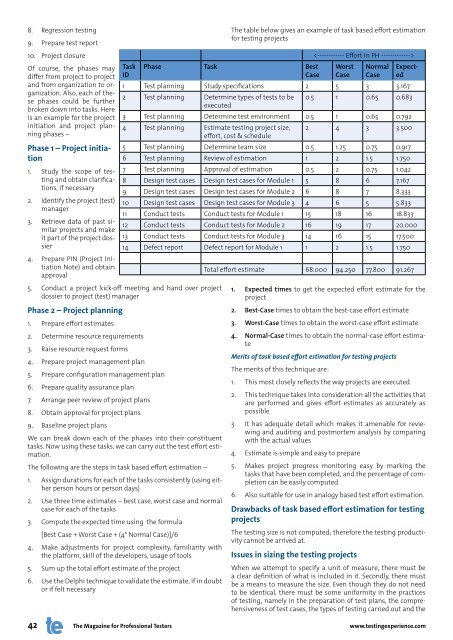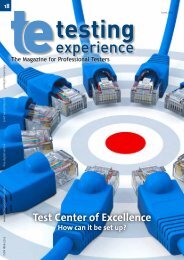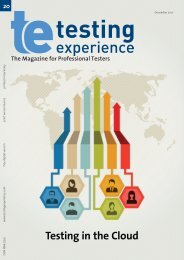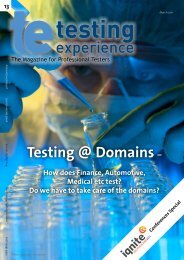Agile Performance Testing - Testing Experience
Agile Performance Testing - Testing Experience
Agile Performance Testing - Testing Experience
You also want an ePaper? Increase the reach of your titles
YUMPU automatically turns print PDFs into web optimized ePapers that Google loves.
8. Regression testing<br />
9. Prepare test report<br />
10. Project closure<br />
Of course, the phases may<br />
differ from project to project<br />
and from organization to organization.<br />
Also, each of these<br />
phases could be further<br />
broken down into tasks. Here<br />
is an example for the project<br />
initiation and project planning<br />
phases –<br />
Phase 1 – Project initiation<br />
1. Study the scope of testing<br />
and obtain clarifications,<br />
if necessary<br />
2. Identify the project (test)<br />
manager<br />
3. Retrieve data of past similar<br />
projects and make<br />
it part of the project dossier<br />
4. Prepare PIN (Project Initiation<br />
Note) and obtain<br />
approval<br />
5. Conduct a project kick-off meeting and hand over project<br />
dossier to project (test) manager<br />
Phase 2 – Project planning<br />
1. Prepare effort estimates<br />
2. Determine resource requirements<br />
3. Raise resource request forms<br />
4. Prepare project management plan<br />
5. Prepare configuration management plan<br />
6. Prepare quality assurance plan<br />
7. Arrange peer review of project plans<br />
8. Obtain approval for project plans<br />
9. Baseline project plans<br />
Task<br />
ID<br />
We can break down each of the phases into their constituent<br />
tasks. Now using these tasks, we can carry out the test effort estimation.<br />
The following are the steps in task based effort estimation –<br />
1. Assign durations for each of the tasks consistently (using either<br />
person hours or person days)<br />
2. Use three time estimates – best case, worst case and normal<br />
case for each of the tasks<br />
3. Compute the expected time using the formula<br />
[Best Case + Worst Case + (4* Normal Case)]/6<br />
4. Make adjustments for project complexity, familiarity with<br />
the platform, skill of the developers, usage of tools<br />
5. Sum up the total effort estimate of the project<br />
6. Use the Delphi technique to validate the estimate, if in doubt<br />
or if felt necessary<br />
The table below gives an example of task based effort estimation<br />
for testing projects<br />
Phase Task Best<br />
Case<br />
1. Expected times to get the expected effort estimate for the<br />
project<br />
2. Best-Case times to obtain the best-case effort estimate<br />
3. Worst-Case times to obtain the worst-case effort estimate<br />
4. Normal-Case times to obtain the normal-case effort estimate<br />
Merits of task based effort estimation for testing projects<br />
The merits of this technique are:<br />
1. This most closely reflects the way projects are executed<br />
2. This technique takes into consideration all the activities that<br />
are performed and gives effort estimates as accurately as<br />
possible<br />
3. It has adequate detail which makes it amenable for reviewing<br />
and auditing and postmortem analysis by comparing<br />
with the actual values<br />
4. Estimate is simple and easy to prepare<br />
5. Makes project progress monitoring easy by marking the<br />
tasks that have been completed, and the percentage of completion<br />
can be easily computed<br />
6. Also suitable for use in analogy based test effort estimation.<br />
Drawbacks of task based effort estimation for testing<br />
projects<br />
The testing size is not computed; therefore the testing productivity<br />
cannot be arrived at.<br />
Issues in sizing the testing projects<br />
<br />
When we attempt to specify a unit of measure, there must be<br />
a clear definition of what is included in it. Secondly, there must<br />
be a means to measure the size. Even though they do not need<br />
to be identical, there must be some uniformity in the practices<br />
of testing, namely in the preparation of test plans, the comprehensiveness<br />
of test cases, the types of testing carried out and the<br />
42 The Magazine for Professional Testers www.testingexperience.com<br />
Worst<br />
Case<br />
Normal<br />
Case<br />
Expected<br />
1 Test planning Study specifications 2 5 3 3.167<br />
2 Test planning Determine types of tests to be<br />
executed<br />
0.5 1 0.65 0.683<br />
3 Test planning Determine test environment 0.5 1 0.65 0.792<br />
4 Test planning Estimate testing project size,<br />
effort, cost & schedule<br />
2 4 3 3.500<br />
5 Test planning Determine team size 0.5 1.25 0.75 0.917<br />
6 Test planning Review of estimation 1 2 1.5 1.750<br />
7 Test planning Approval of estimation 0.5 2 0.75 1.042<br />
8 Design test cases Design test cases for Module 1 5 8 6 7.167<br />
9 Design test cases Design test cases for Module 2 6 8 7 8.333<br />
10 Design test cases Design test cases for Module 3 4 6 5 5.833<br />
11 Conduct tests Conduct tests for Module 1 15 18 16 18.833<br />
12 Conduct tests Conduct tests for Module 2 16 19 17 20.000<br />
13 Conduct tests Conduct tests for Module 3 14 16 15 17.500<br />
14 Defect report Defect report for Module 1 1 2 1.5 1.750<br />
Total effort estimate 68.000 94.250 77.800 91.267









